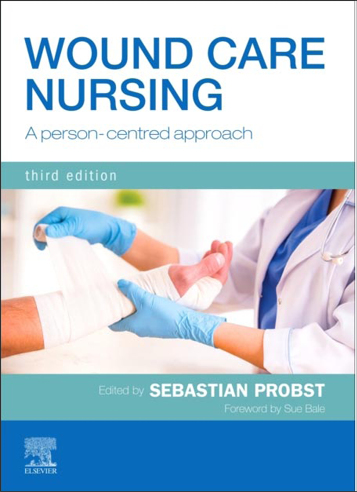Volume 22 Number 2
Wound Care Nursing A person-centered approach
Sebastian Probst, ed.: 3rd Edition. Elsevier 2020
Abstract
Injury to the skin can often lead to wounds that are considered recalcitrant or difficult to heal. Wound care is central to nursing practice. To address the growing demand and exorbitantly high cost of wound management, there is a need to shift from a mechanistic, diseased-oriented perspective to a more humanistic practice paradigm that views patients as active partners.

Wound Care Nursing. A person-centered approach, edited by Sebastian Probst, is a concise introductory text for nurses to better understand the intricate interplay among risk factors, comorbidities, patient preferences and system barriers that can affect the healing process. Crucial to the successful management of complex wounds are nursing processes that promote a systematised and methodical approach to assessment, diagnosis, planning, implementation and (re)evaluation. Guided by nursing models, the authors describe the importance of exploring patients’ experiences and integrating them into the plan of care.
Age-related differences in wound care have been documented. What makes this book unique is its life span perspective, which highlights the most relevant wound types within each major period of life. The chapter on neonates and young children focuses on caring for extravasation injuries, histiocytosis X, meningitis and burns. Another chapter is devoted to the care of cutaneous injuries caused by road traffic accidents and chemical exposure, which are common among teenagers. Wound care for young adults includes surgical interventions for pilonidal sinuses, childbirth, trauma and self-inflicted wounds. Wound care for middle-aged people involves the assessment and management of diabetic foot ulceration. Key practice recommendations for conditions such as incontinence-associated dermatitis, pressure ulcers and leg ulcerations, to which older individuals are often vulnerable, are also included. Individuals’ risks and responses to wound care are largely shaped by skin characteristics, the environment and their developmental challenges. As nurses, our effort to unravel the socio-cultural context, placing the patient/client at the centre of care delivery, is key to cultivating person-centredness.
To demystify how person-centred care is implemented, a discussion of each condition is accompanied with real-world scenarios that are commonly encountered in clinical practice. Story-telling is an effective learning tool. Through these stories, abstract information is put into a framework that is easy for the reader to relate to, understand and translate into practice. I highly recommend this book for nurses and other health care practitioners.
Author(s)
Sebastian Probst, ed.: 3rd Edition. Elsevier 2020
Dr Kevin Woo, PhD, RN, NSWOC WOCC(C), Associate Professor, Queen’s University, 92 Barrie Street, Kingston, Ontario K7L 3N6, Canada
